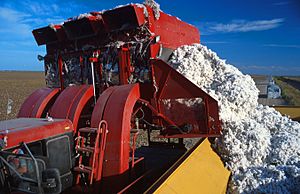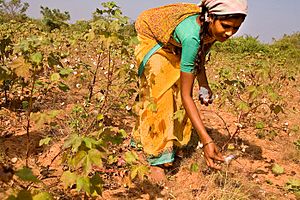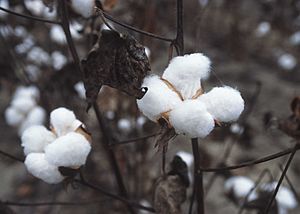Cotton facts for kids
Cotton is a soft fiber that grows with the seeds of the cotton plant. (A fiber is a long, thin strand, like hair.) After cotton is picked from the plant, it can be made into thread. This thread can then be woven into cloth. Cotton cloth is used to make clothes for people and many other things. Cotton clothing feels nice to wear, especially in warm weather, and is easy to move in. Cotton is related to plants like okra and hibiscus.
There are different kinds of cotton plants. Some grow naturally in warm, tropical, and subtropical parts of the world. This is how people first found cotton many years ago. Most of the cotton used today comes from plants grown on farms. Cotton farms are found in Africa, Asia, Europe, Australia, and the Americas. Cotton is very good at soaking up water, absorbing up to 24-27 times its own weight! Every part of the cotton plant can be useful.
Around the world, about 25 million tons (or 110 million bales) of cotton are produced each year. This uses about 2.5% of the world's farmland. China grows the most cotton, but most of it is used within China. The United States has been the biggest exporter (seller to other countries) for many years.
Contents
History of Cotton
People have used cotton to make light, fine cloth in warm places for thousands of years. Some experts believe that ancient Egyptians might have had cotton as early as 12,000 BC. In Mexican caves, scientists found cotton cloth and pieces of fiber mixed with feathers and fur that are about 7,000 years old. There is also proof that people in South America and India started growing different types of cotton plants on their own thousands of years ago. Cotton has been grown in India for over three thousand years. By the late 16th century BC, cotton had spread to warmer areas in the Americas, Africa, and Eurasia.
The cotton industry in India changed a lot during the Industrial Revolution in Great Britain. New machines like the Spinning Jenny (invented in 1764) and Arkwright's spinning frame (1769) made it possible to produce cotton cloth cheaply and in large amounts in the United Kingdom. The process became even faster when Eli Whitney invented the cotton gin in 1793.
Growing Cotton
Cotton plants belong to the mallow family, which also includes pretty flowers like hollyhocks and hibiscus. The soft cotton fiber grows around the seeds of the plant. This fiber helps the seeds travel far on the wind, allowing new plants to grow in different places. Early humans realized that these soft, fluffy fibers could be used to make cloth. They began to breed cotton plants, choosing varieties that had fluffier fibers that were easier to spin into thread.
Cotton is a natural fiber that comes from the cotton plant. It is one of the oldest fibers grown by humans, with traces of cotton found at ancient sites that are over 7,000 years old. Today, cotton is still one of the most used natural fibers. People all over the world wear and use cotton for many different things. Millions of acres of land globally are used to grow cotton. There are "new world" cotton types with longer, smoother fibers and "old world" types with shorter, coarser fibers.
How Cotton is Harvested


Most cotton today is picked by machines. There are two main types: a cotton picker, which removes only the cotton from the plant without harming it, and a cotton stripper, which pulls the entire cotton boll off the plant. However, in many developing countries, cotton is still picked by hand.
After cotton is harvested, it needs to be cleaned to remove the seeds. In the past, this was a very hard and slow job. But during the Industrial Revolution, the cotton gin was invented. This machine quickly separates the seeds from the fiber and combs the fibers, getting them ready for spinning. A single cotton fiber isn't very strong on its own. But when many curling fibers are straightened and twisted together, they form a strong, smooth thread. This thread can then be knitted or woven into fabric and dyed many colors.
Turning Cotton into Cloth
After cotton is harvested from the farm, it goes through several important steps to become cloth. Before the fabric is made, there are three main stages:
- Ginning: This is where the cotton fibers are separated from the seeds.
- Spinning: The cleaned cotton fibers are twisted together to make strong thread or yarn.
- Weaving: The threads are woven together on a loom to create fabric.
After weaving, the cotton fabric usually goes through more processing steps. Sometimes, the fabric can be used directly after some of these stages. For example, unbleached cloth is used for things like grain bags. Typical stages for finishing cotton fabric include:
- Singeing: Burning off tiny fibers from the surface to make it smooth.
- Desizing: Removing sizing agents that were added to the yarn for weaving.
- Scouring: Cleaning the fabric to remove natural oils, waxes, and dirt.
- Bleaching: Making the fabric whiter by removing natural colors.
- Mercerizing: Treating the fabric to make it stronger, shinier, and easier to dye.
- Dyeing: Adding color to the fabric.
- Finishing: Applying special treatments to give the fabric certain qualities, like being wrinkle-resistant.
What Cotton is Used For
Besides making clothes and other textiles, cotton is used for many other things. It can be found in fishnets, coffee filters, and tents. Cotton is also used in bookbinding. The first paper made in China used cotton fiber. Even today, the modern dollar bill and government stationery are made from cotton fiber. Fire hoses used to be made of cotton.
Denim, a strong type of cloth, is mostly made of cotton. Your favorite T-shirts are also often made of cotton.
After the cotton fibers are removed from the seeds (a process called ginning), the leftover cottonseed is very useful. It is pressed to produce cottonseed oil. After being cleaned, this oil can be used by people, just like other vegetable oils. The remaining cottonseed meal is usually fed to livestock like cows.
Images for kids
-
Cotton plants as imagined and drawn by John Mandeville in the 14th century
-
A woman in Dhaka clad in fine Bengali muslin, 18th century
-
Picking cotton in Armenia in the 1930s. No cotton is grown there today.
-
Cotton ready for shipment, Houston, Texas (postcard, circa 1911)
-
Hoeing a cotton field to remove weeds, Greene County, Georgia, US, 1941
-
Female and nymph cotton harlequin bug
-
A display from a British cotton manufacturer of items used in a cotton mill during the Industrial Revolution
-
A bale of cotton on display at the Louisiana State Cotton Museum in Lake Providence in East Carroll Parish in northeastern Louisiana
-
Cotton fibers viewed under a scanning electron microscope
See also
 In Spanish: Algodón para niños
In Spanish: Algodón para niños


























